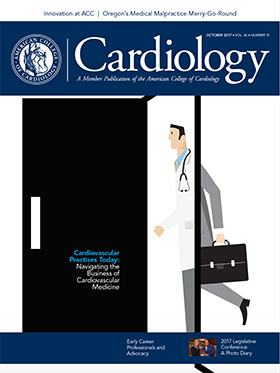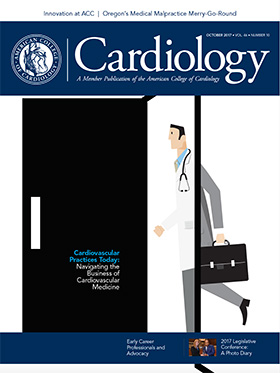ACCEL | AMULET: Observational Study of LAA Closure


In this ACCEL interview, Anthony N. DeMaria, MD, MACC, is joined by David Hildick-Smith, MD, to talk about the results of the observational AMULET study of left atrial appendage (LAA) closure.
Dr. DeMaria: Dr. Hildick-Smith, please tell us about the Amulet device.
Dr. Hildick-Smith: Amulet is a nitinol-based device delivered to the LAA via a transseptal puncture. This is usually done under general anesthesia with transesophageal control. The device has two main components. A lobe shaped like a car tire with some retaining wires that point in the opposite direction of the appendage that anchors it after the lobe is open and fixed in place. And a very short connecting waist to a disc that’s flat and designed to seal off the ostium of the appendage from just below the left upper pulmonary vein to just above the anterior leaflet of the mitral valve.
Tell us about your study and how efficacy and safety of this device were evaluated.
The AMULET observational study has roughly 1,000 patients, and is an international, prospective, multicenter registry. Follow-up is two years. We’re now reporting immediate safety and efficacy and complications through the first seven days. We also have transesophageal echocardiography (TEE) data from the core lab analysis on the device placement and any residual leaks at one to three months.
How many centers participated and where are they?
There are 64 participating sites in Europe, the Middle East, Asia, Australia and South America. Of the 1,073 patients, we have data locked on 711.
Did all the patients have contraindications to anticoagulants?
The vast majority, about 80 percent, had relative or absolute contraindications. Some patients had a stroke despite ongoing anticoagulation. There was a very small proportion, less than 5 percent, that was the patient choice, and for a very small proportion with labile INR, their doctors elected to enroll them.
"[T]he majority of operators were relatively early in their learning experience with LAA occluders. Many operators may have had an opportunity to use the previous version of the device, but not many will have done more than, say, 100 cases." — David Hildick-Smith, MD
Was this an elderly population?
The average age was 75. About two-thirds were men. All patients had non-valvular atrial fibrillation. There was quite a high prevalence of previous stroke, diabetes and hypertension. About three-quarters had a history of major bleeding.
How difficult was it to place the Amulet device?
The technical success rate was very good, with successful device placement in the LAA in 1,060 of the 1,073 patients. Of the 13 unsuccessful cases, the procedure wasn’t attempted due to thrombus in the appendage in some cases, I believe it was six. The technical failure rate was less than one percent.
That’s very striking, because I assume this was early in the experience of the operators.
I think you’re absolutely right that the majority of operators were relatively early in their learning experience with LAA occluders. Many operators may have had an opportunity to use the previous version of the device, but not many will have done more than, say, 100 cases.
Were there any adverse events?
The complication rate in this group out to seven days was 2.7 percent. So not trivial but not huge. The complications included a couple of patients who died and a couple of patients who had a stroke.
They died as a result of the procedure?
Probably, yes. I think it’s reasonably clear that if they hadn’t had the procedure, they probably wouldn’t have died. A couple of people had a stroke and several had pericardial effusions. One embolization occurred, which is a very small number and quite striking. Ten patients had major bleeding. There was a small collection of other individual major complications like pulmonary edema.
But in aggregate, less than three percent had complications?
Yes. It’s not yet at the level we can say this is a benign procedure and it should be moved into the wider population for anyone with atrial fibrillation. The complication rates are coming down from the first reports of this technique through PROTECT AF when the rates were significantly higher. A similar lowering of complication rates was shown in the recent EWOLUTION report.
What do the data show regarding leaks or residual areas where thrombi could form?
We have TEE results in nearly 600 cases. In 99 percent, there was no residual flow greater than 3 millimeters in diameter. The same result was seen in 99 percent of the 360 patients who were assessed during the follow-up between one to three months. This near lack of residual flow speaks to the design of the device and the technique for implanting with a lobe and a lid in the sense that there’s two bites at closing off any flow. So, it’s not a surprise to me that this aspect of the study is very strong.
No clots, no pouches?
There aren’t any recesses for clots to form, if you like, so that’s theoretically a good feature of this device. During the first seven days, there were two patients in whom clot was seen on the device. On TEE, conducted for reasons not directly related to the study, some clot was seen, but no adverse event occurred.
Were they routinely anticoagulated after placement?
No. This is a potential strength of the device. Overall, 80 percent of study patients didn’t have any form of anticoagulation. In WATCHMAN, conducted in patients who could take warfarin, the drug was given for 45 days. In AMULET, the vast majority have had dual antiplatelet or even single antiplatelet therapy. We’ll have wait to see their stroke outcomes in the longer term. Early indications from this study and from previous nitinol-based technologies is that antiplatelet agents should be enough.
Tweet this article: Tweet
This interview has been edited for print from a transcript.
 |
|
| Click the cover image above to read the latest issue of Cardiology in e-pub format or click here to read it on the web! | |
Keywords: ACC Publications, Cardiology Magazine, Aged, Warfarin, Anticoagulants, Atrial Fibrillation, Atrial Appendage, Platelet Aggregation Inhibitors, Echocardiography, Transesophageal, Pulmonary Veins, Mitral Valve, Pericardial Effusion, Pulmonary Edema, Prevalence, Prospective Studies, Follow-Up Studies, International Normalized Ratio, Thrombosis, Stroke, Hemorrhage, Hypertension, Registries, Punctures, Diabetes Mellitus, Anesthesia, General
< Back to Listings

